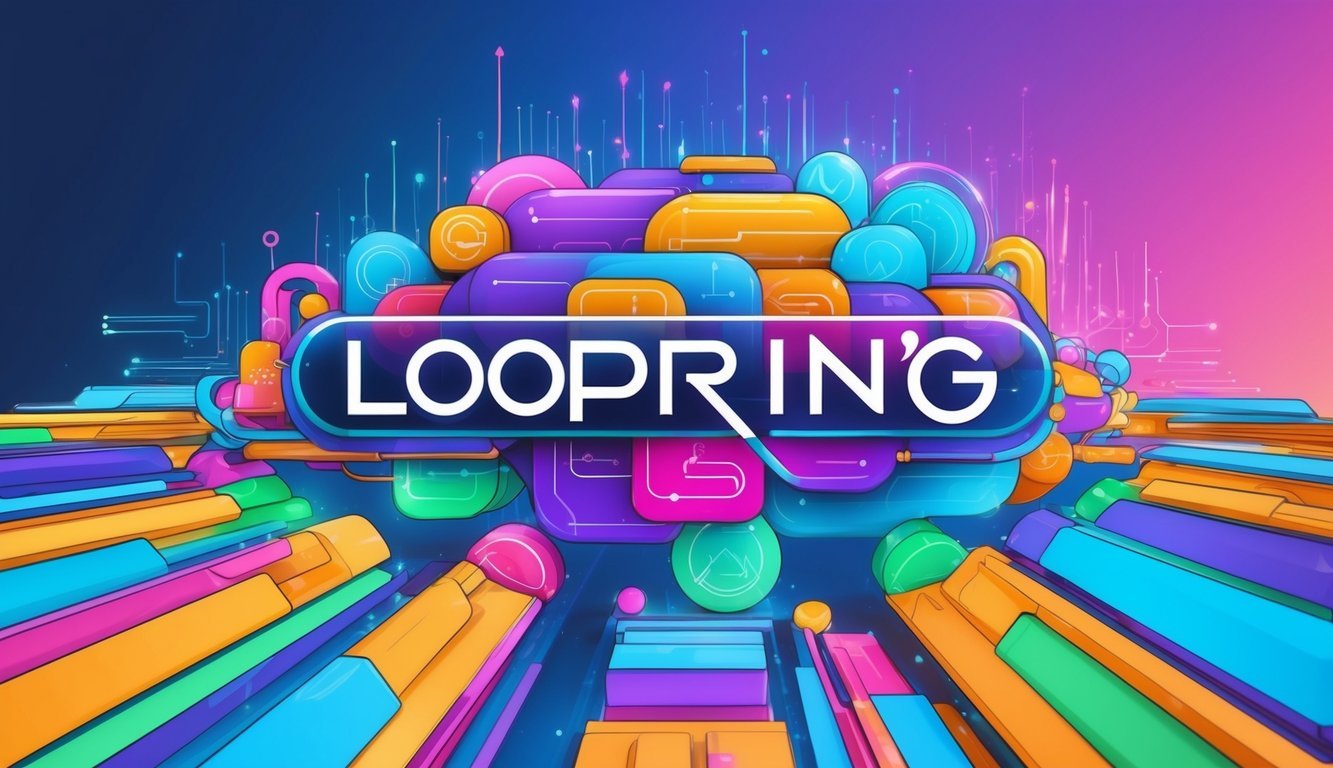Loopring is a cool tech project that’s changing how we trade crypto. It’s built on top of Ethereum and aims to make buying and selling digital assets faster and cheaper.
Loopring (LRC) uses innovative tech to improve the speed and cost of cryptocurrency trades.

You might be wondering why Loopring is getting so much attention lately. Well, it’s because it tackles some big problems in the crypto world. It helps reduce fees, speeds up transactions, and keeps your trades secure. Plus, it has its own token called LRC, which you can use or invest in.
Loopring isn’t just for crypto nerds. If you’re into trading or just curious about the future of finance, it’s worth knowing about. It’s part of a bigger trend called DeFi (decentralized finance) that’s shaking up how we think about money and trading.
Key Takeaways
- Loopring makes crypto trading faster and cheaper on Ethereum.
- You can use Loopring to trade or invest in its LRC token.
- It’s part of the growing DeFi movement in cryptocurrency.
Understanding Loopring Technology
Loopring uses cutting-edge tech to make trading crypto faster and cheaper. It builds on Ethereum but adds special features to speed things up and keep costs down.
The Basics of Decentralized Exchanges
Decentralized exchanges let you trade crypto without a middleman. You keep control of your money and don’t need to trust a company. Loopring helps create these exchanges.
With Loopring, you can swap tokens directly from your wallet. No need to deposit funds on a website first. This makes trading safer and more private.
Loopring’s tech also helps match buy and sell orders fast. It can handle lots of trades at once, so you don’t have to wait.
Why Layer 2 on Ethereum Matters
Ethereum is great, but it can get slow and pricey when busy. That’s where Layer 2 solutions come in. They work on top of Ethereum to make it faster and cheaper.
Loopring is a Layer 2 solution. It processes trades off the main Ethereum chain. This means you can trade quickly without high fees.
Your funds stay safe because Loopring still uses Ethereum’s security. You get the best of both worlds – speed and safety.
zkRollup: The Engine Behind Loopring
zkRollup technology is the secret sauce of Loopring. It bundles lots of trades together and proves they’re valid using math.
This tech lets Loopring handle up to 2,025 trades per second. That’s way more than Ethereum alone can do.
Your trades are private too. zkRollup hides the details but proves everything is correct. This keeps your info safe while making sure no one cheats.
Loopring’s Ecosystem and LRC Token
Loopring’s ecosystem revolves around its native token, LRC. This token plays a key role in governance, staking, and powering various features of the protocol.
The Role of LRC in the Loopring Ecosystem
LRC is the backbone of the Loopring network. You can use it to pay fees, participate in governance, and access special features. When you trade on Loopring’s decentralized exchange (DEX), you’ll often see LRC as a trading pair.
The token also helps secure the network. By staking LRC, you can become a liquidity provider. This means you’re helping to make trades smoother for everyone.
Loopring’s DAO (Decentralized Autonomous Organization) uses LRC for voting. If you hold LRC, you get a say in the future of the protocol. It’s like being a shareholder in a company, but for a decentralized platform.
Tokenomics and LRC Supply Mechanics
LRC has some interesting supply mechanics. The total supply isn’t fixed – it can change over time. Here’s how it works:
- Burning: Some fees paid in LRC get burned, reducing the total supply.
- Minting: New LRC can be created as rewards for liquidity providers and stakers.
This balance of burning and minting helps keep the LRC price stable. It also rewards users who help the network run smoothly.
The LRC price can be volatile, like many crypto tokens. It’s affected by overall market conditions and Loopring’s development progress.
Staking and Earning on Loopring
You can earn rewards by staking your LRC tokens. Here’s how:
- Provide liquidity: Add your LRC to trading pools on the Loopring DEX.
- Stake in the protocol: Lock up your LRC to help secure the network.
When you stake, you earn a share of the protocol fees. The more you stake, the more you can earn. But remember, staking means you can’t use those tokens for a while.
Loopring also has a VIP program for big stakers. If you stake a lot of LRC, you get perks like lower trading fees and higher rewards.
Trading on Loopring
Loopring offers fast and cheap trading on Ethereum. You can buy and sell crypto without giving up control of your funds. The system keeps fees low while handling lots of trades.
How to Buy and Sell on a Non-Custodial Exchange
To trade on Loopring, you’ll need to connect a wallet like MetaMask. Then you can deposit funds to the Layer 2 network. This step is quick and cheap.
Once your funds are on Layer 2, you can start trading. The order book shows current prices and amounts. You can set limit orders or make instant swaps.
Trading is non-custodial, so you keep control of your crypto. No need to trust a central exchange with your funds. If you want to cash out, just withdraw back to Layer 1 Ethereum.
Transaction Fees and Market Dynamics
Loopring keeps fees super low thanks to its tech. You’ll pay way less than on Ethereum mainnet or centralized exchanges like Binance or Coinbase.
The fee for trades is about 0.1% of the amount. Deposits and withdrawals cost a bit extra. But overall, it’s much cheaper than other options.
Low fees help boost trading volume and liquidity. More trades mean tighter spreads and better prices for you. The market cap of LRC tokens also affects trading activity.
Keep an eye on gas prices if you’re moving funds on or off the network. But once you’re on Layer 2, trading is fast and cheap.
Investing in Loopring

Want to get in on the Loopring action? You’ve got options! The main way to invest is by buying LRC, the native token of the Loopring network.
You can purchase LRC on various crypto exchanges. Some popular ones include Coinbase, Binance, and KuCoin. Make sure to do your homework and compare fees before picking an exchange.
LRC’s price has seen some big swings. Its all-time high was $3.83 in November 2021. The all-time low? A measly $0.019 back in March 2020. Talk about a rollercoaster!
Keep an eye on Loopring’s market cap too. It gives you a sense of the project’s overall value compared to other cryptos. As of November 2024, LRC’s market cap is fluctuating, so check the latest figures before investing.
Here are some quick pros and cons to consider:
Pros:
• Innovative Layer 2 scaling solution
• Growing ecosystem of dApps
• Potential for future growth
Cons:
• High competition in the Layer 2 space
• Price volatility
• Regulatory uncertainties
Remember, crypto investing can be risky. Only invest what you can afford to lose, and always do your own research before jumping in.
Frequently Asked Questions

Loopring offers a unique wallet and mining system. Its price changes based on various factors. The protocol integrates closely with Ethereum and provides several key benefits to users.
How do you use a Loopring wallet?
To use a Loopring wallet, you’ll need to download the app on your smartphone. Once installed, create an account and set up your wallet.
You can then add funds, trade tokens, and use decentralized apps. The wallet lets you access Loopring’s layer 2 scaling solution for faster and cheaper transactions.
Can you mine Loopring, and if so, how?
You can’t mine Loopring in the traditional sense. Instead, Loopring uses a system called ring miners.
These miners execute orders and earn LRC tokens as rewards. To become a ring miner, you’ll need to run special software and stake LRC tokens.
What drives Loopring’s price changes?
Loopring’s price changes based on supply and demand. New partnerships, protocol upgrades, and increased adoption can drive up the price.
Market trends and overall crypto sentiment also play a role. Keep an eye on Loopring’s development progress and user growth for potential price indicators.
What are some predictions for Loopring’s future value?
Predicting crypto prices is tricky and often unreliable. Some experts believe Loopring could grow due to its scaling solutions and DeFi potential.
Others are more cautious, citing competition and market volatility. It’s best to do your own research and consider multiple viewpoints before investing.
How does Loopring integrate with Ethereum?
Loopring is built on top of Ethereum as a layer 2 scaling solution. It processes transactions off-chain and then settles them on Ethereum. This approach not only enhances transaction speed and reduces costs but also maintains the security and decentralization features of the Ethereum network. By using techniques such as zk-Rollups, Loopring can bundle multiple transactions together, allowing for efficient processing and minimal on-chain data. Additionally, as blockchain technology evolves, concepts like sharding explained in blockchain become increasingly relevant, further contributing to scalability and performance improvements across various platforms.
This integration allows for faster and cheaper transactions while maintaining Ethereum’s security. Loopring also supports Ethereum-based tokens and smart contracts.
What are the main advantages of using Loopring?
Loopring offers several key benefits. You’ll enjoy lower transaction fees and faster processing times compared to Ethereum’s base layer.
The protocol provides high security through its decentralized design. You also get access to a range of DeFi services and the ability to trade directly from your wallet.




